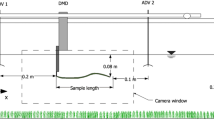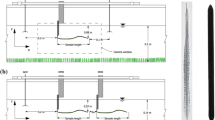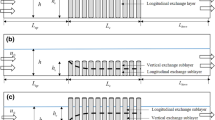Abstract
Flow–plant interactions are experimentally investigated at leaf, stem, and shoot scales in an open-channel flume at a range of Reynolds numbers. The experiments included measurements of instantaneous drag forces acting on leaves, stems, and shoots of the common freshwater plant species Glyceria fluitans, complemented with velocity measurements, high-resolution video recordings, and biomechanical tests of leaf and stem properties. The analyses of bulk statistics, power spectral densities, transfer functions, and cross-correlations of measured velocities and drag forces revealed that flow characteristics, drag force, and plant biomechanical and morphological properties are strongly interconnected and scale-dependent. The plant element–flow interactions can be subdivided into two classes: (I) passive interactions when the drag variability is due to the time variability of the wetted and frontal areas and squared approach velocity (due to the large-scale turbulence); and (II) active interactions representing a range of element-specific instabilities that depend on the element flexural rigidity and morphology. Implications of experimental findings for plant biophysics and ecology are briefly discussed.




















Similar content being viewed by others
Abbreviations
- ADV:
-
Acoustic Doppler velocimeter
- A :
-
Reference area
- A f :
-
Frontal projection area of plant
- A i :
-
Characteristic plant diameter × lateral projection plant height
- A w :
-
Total wetted area
- α :
-
Vogel number
- B :
-
Mean leaf width or mean stem diameter
- C d :
-
Drag coefficient
- \(C_{d - FPL}\) :
-
Drag coefficient of laminar flat plate flow
- \(C_{d - FPT}\) :
-
Drag coefficient of turbulent flat plate flow
- \(C_{xy}\) :
-
Covariance function
- CV :
-
Coefficient of variation
- d :
-
Characteristic plant diameter
- \(\Delta z\) :
-
Leaf ridge height
- \(\delta\) :
-
Viscous sublayer height
- \(\delta^{ + }\) :
-
Normalised height of the viscous sublayer
- DMD:
-
Drag measurement device
- E:
-
‘Tension’ Young’s modulus
- Eb :
-
‘Bending’ Young’s modulus
- EI:
-
Flexural rigidity
- f :
-
Frequency
- f s :
-
Sampling frequency
- F :
-
Mean drag force
- \(F_{m}\) :
-
Total mean drag force (i.e., tip + leaf)
- \(\hat{F}_{m}\) :
-
Instantaneous total drag force (i.e., tip + leaf)
- \(F_{t}\) :
-
Mean drag force acting on the rod tip
- \(\hat{F}_{t}\) :
-
Instantaneous drag force acting at the rod tip
- h :
-
Water depth
- h i :
-
Height of the lateral projection of plant
- I :
-
Second moment area
- K d :
-
Kurtosis coefficient
- L :
-
Leaf, stem or shoot length
- L f :
-
Length of plant lateral projection
- LFTF:
-
Leaf force transfer function
- LBL:
-
Leaf boundary layer
- LVTF:
-
Leaf velocity transfer function
- \(MR_{{\hat{F}_{m} u_{d} }}\) :
-
Average of maximum cross-correlation coefficients between drag force and downstream velocity
- \(MR_{{u_{a} \hat{F}_{m} }}\) :
-
Average of maximum cross-correlation coefficients between approach velocity and drag force
- \(MR_{{u_{a} u_{d} }}\) :
-
Average of maximum cross-correlation coefficients between approach velocity and downstream velocity
- n :
-
Number of samples
- PSD:
-
Power spectral density
- Q :
-
Discharge
- \(R_{xy}\) :
-
Cross-correlation function
- \(R_{{\hat{F}_{m} U_{d} }}\) :
-
Cross-correlation function between drag force and downstream velocity
- \(R_{{u_{a} \hat{F}_{m} }}\) :
-
Cross-correlation function between approach velocity and drag force
- \(R_{{u_{a} u_{d} }}\) :
-
Cross-correlation function between approach and downstream velocities
- Re:
-
Reynolds number
- Re h :
-
Depth-based Reynolds number
- Re L :
-
Plant length-based Reynolds number
- \(\text{Re}_{Lc}\) :
-
Critical Reynolds number for transition from laminar boundary layer to the turbulent boundary layer
- \(\rho\) :
-
Fluid density
- \(\sigma_{d}\) :
-
Standard deviation of drag force
- \(\sigma_{{u_{a} }}^{{}}\) :
-
Standard deviation of approach velocity
- \(\sigma_{{u_{d} }}\) :
-
Standard deviation of the downstream velocity
- \(\sigma_{m}^{2}\) :
-
Total variance of drag force
- \(\sigma_{t}^{2}\) :
-
Variance related to the rod tip
- \(\sigma_{{u_{a} }}^{2}\) :
-
Variance of approach velocity
- S b :
-
Flume bed slope
- S d :
-
Skewness coefficient
- \(S_{{\hat{F}_{m} }}\) :
-
Power spectral density of drag force
- \(S_{{u_{a} }}\) :
-
Power spectral density of approach velocity
- \(S_{{u_{d} }}\) :
-
Power spectral density of downstream velocity
- SFTF:
-
Shoot force transfer function
- SVTF:
-
Shoot velocity transfer function
- STFTF:
-
Stem force transfer function
- STVTF:
-
Stem velocity transfer function
- t :
-
Time
- \(\tau\) :
-
Time lag
- \(\tau_{0}\) :
-
Mean shear stress at a leaf surface
- u :
-
Instantaneous longitudinal velocity
- u′ :
-
Fluctuating component of longitudinal velocity
- \(u_{*}\) :
-
Friction velocity
- U :
-
Time-averaged longitudinal velocity
- U a :
-
Time-averaged velocity in front of a shoot or its parts
- U f :
-
Undisturbed velocity integrated over A f
- U i :
-
Undisturbed velocity integrated over h i
- U m :
-
Cross-sectional average velocity
- \(\upsilon\) :
-
Fluid kinematic viscosity
- \(z^{ + }\) :
-
Leaf ridge Reynolds number
- \(\overline{{z^{ + } }}\) :
-
Average \(z^{ + }\)
References
Albayrak I, Nikora V, Miler O, O’Hare M (2012) Flow–plant interaction at a leaf scale: effects of leaf shape, edge, roughness and flexural rigidity. Aquat Sci 74(2):267–286
Alben S, Shelley M, Zhang J (2002) Drag reduction through self-similar bending of a flexible body. Nature 420:479–481
Alben S, Shelley M, Zhang J (2004) How flexibility induces streamlining in a two-dimensional flow. Phys Fluids 16:1694–1713
Armanini A, Righetti M, Grisenti P (2005) Direct measurement of vegetation resistance in prototype scale. J Hydraul Res 43:481–487
Boller ML, Carrington E (2006) The hydrodynamic effects of shape and size change during reconfiguration of a flexible macroalga. J Exp Biol 209:1894–1903
Carruthers AC, Filippone (2005) Aerodynamic drag of streamers and flags. J Aircraft 42:976–982
Chen JM, Ibbetson A, Milford JR (1988) Boundary-layer resistances of artificial leaves in turbulent air: I. leaves inclined to the mean flow. Bound Lay Meteorol 45:371–390
Dodds W (2002) Freshwater ecology. Concepts and environmental applications. Academic Press, London
Elder JW (1960) The flow past a flat plate of finite width. J Fluid Mech 9:133–153. doi:10.1017/S0022112060000979
Ennos AR (1999) The aerodynamics and hydrodynamics of plants. J Exp Biol 202:3281–3284
Fathi-Moghadam M, Kouwen N (1997) Nonrigid, nonsubmerged, vegetative roughness on floodplains. J Hydraul Eng ASCE 123:51–57
Goring D, Nikora V (2002) De-spiking ADV data. J Hydraul Eng ASCE 128:117–126
Gosselin F, de Langre E (2011) Drag reduction by reconfiguration of a poroelastic system. J Fluid Struct 27(7):1111–1123
Gosselin F, de Langre E, Machado-Almeida B (2010) Drag reduction of flexible plates by reconfiguration. J Fluid Mech 650:319–341
Green JC (2005) Further comment on drag and reconfiguration of macrophytes. Freshwater Biol 50:2162–2166
Järvelä J (2002) Flow resistance of flexible and stiff vegetation: a flume study with natural plants. J Hydrol 269(1/2):44–54
Jones JI, Eaton JW, Hardwick K (2000) The effect of changing environmental variables in the surrounding water on the physiology of Elodea nuttallii. Aquat Bot 66:115–129
Jumars PA, Eckaman JE, Koch E (2001) Macroscopic animals and plants in benthic flows. In: Boudreau BP, Jorgensen BB (eds) The benthic boundary layer. Oxford University Press, Oxford, pp 320–347
Koehl MAR (1999) Ecological biomechanics of bethic organisms: life history, mechanical design and temporal patterns of mechanical stress. J Exp Biol 202:3469–3476
Levin D, Daser G, Shpund Z (1997) On the aero dynamic Drag of Ribbons. AIAA 97–1525. pp 402–408
Luhar M, Nepf HM (2011) Flow-induced reconfiguration of buoyant and flexible aquatic vegetation. Limnol Oceanogr 56(6):2003–2017
Madsen TV, Maberly SC (2003) High internal resistance to CO2 uptake by submerged macrophytes that use HCO3 −: measurements in air, nitrogen and helium. Photosyn Res 77:183–190
Miler O, Albayrak I, Nikora V, O’Hare M (2012) Biomechanical properties of aquatic plants and their effects on plant–flow interactions in streams and rivers. Aquat Sci 74(1):31–44
Nezu I, Nakagawa H (1993) Turbulence in open-channel flows. IAHR Monograph. A.A. Balkema, Rotterdam
Nikora V (2010) Hydrodynamics of aquatic ecosystems: an interface between ecology, biomechanics and environmental fluid mechanics. River Res Appl 26:367–384
Nikora V, Goring DG (2000) Flow turbulence over fixed and weakly mobile gravel beds. J Hydraul Eng ASCE 126:679–690
O’Hare MT, Hutchinson KA, Clarke RT (2007) The drag and reconfiguration experienced by five macrophytes from a lowland river. Aquat Bot 86:253–259
Oplatka M (1998) Stabilitat von Weidenverbauungen an Flussufern, Mitteilungen der Versuchsanstalt fur Wasserbau, Hydrologie und Glaziologie, No. 156, ETH Zurich (Doctoral Thesis)
Preston CD, Croft JM (2001) Aquatic plants in Britain and Ireland. Harley Books, Colchester, p 365, ISBN 0-946589-69-0
Sand-Jensen K (2003) Drag and reconfiguration of freshwater macrophytes. Freshwater Biol 48:271–283
Schlichting H, Gersten K (2000) Boundary layer theory. 8th revised and enlarged edition. Springer, Berlin
Schouveiler L, Boudaoud A (2006) The rolling up of sheets in a steady flow. J Fluid Mech 563:71–80
Schuepp PH (1993) Leaf boundary layers: Tansley review no. 59. New Phytol 125:477–507
Siniscalchi F, Nikora V (2013) Dynamic reconfiguration of aquatic plants and its interrelations with upstream turbulence and drag forces. J. Hydraulic Res 51(1):46–55
Statzner B, Lamouroux N, Nikora V, Sagnes P (2006) The debate about drag and reconfiguration of freshwater macrophytes: comparing results obtained by three recently discussed approaches. Freshwater Biol 51:2173–2183
Sukhodolov A (2005) Comment on drag and reconfiguration of macrophytes. Freshwater Biol 50:194–195
Tani I (1988) Drag reduction by riblet viewed as a roughness problem. Proc Jpn Acad B 64:21–24
Usherwood JR, Ennos AR, Ball DJ (1997) Mechanical adaptations in terrestrial and aquatic buttercups to their respective environments. J Exp Bot 48:1469–1475
Vogel S (1989) Drag and reconfiguration of broad leaves in high winds. J Exp Bot 40:941–948
Vogel S (1994) Life in moving Fluids, 2nd edn. Princeton University Press, Princeton
Vogel S (2009) Leaves in the lowest and highest winds: temperature, force and shape. New Phytol 183:13–26
Vollsinger S, Mitchell SJ, Byrne KE, Novak MD, Rudnicki M (2005) Wind tunnel measurements of crown streamlining and drag relationships for several hardwood species. Can J Forest Res 35:1238–1249
Walsh MJ, Lindemann AM (1984) Optimization and application of riblets for turbulent drag reduction. AIAA paper 84–0347, New York
Wilson CAME, Stoesser T, Bates PD, Batemann PA (2003) Open channel flow through different forms of submerged flexible vegetation. J Hydraul Eng ASCE 129:847–853
Xavier P, Wilson CAME, Aberle J, Rauch H P, Schoneboom T, Lammeranner W, Thomas H (2010) Drag force of flexible submerged trees.” Proc. Hydralab Closing Event, 2–4 February 2010, Hanover, Germany
Zhu L (2008) Scaling laws for drag of a compliant body in an incompressible viscous flow. J Fluid Mech 607:387–400
Zhu L, Peskin C (2002) Simulation of a flapping flexible filament in a flowing soap film by the immersed boundary method. J Comput Phys 179:452–468
Zhu L, Peskin C (2007) Drag of a flexible fiber in a 2D moving viscous fluid. Comp Fluids 36:398–406
Acknowledgments
The work was supported by the Leverhulme Trust, Grant F/00152/Z ‘Biophysics of flow–plant interactions in aquatic systems’. The final stage of this work has been supported by ETH-Zürich, Leibniz Institute of Freshwater Ecology and Inland Fisheries-Berlin, University of Aberdeen, and NERC’s Center for Ecology and Hydrology. The Centre for Ecology and Hydrology (CEH, Edinburgh) supplied the strain gauge equipment used in this work. The authors are grateful to Valentin Eydoux and Santiago Halle for their help with the experimental work.
Author information
Authors and Affiliations
Corresponding author
Rights and permissions
About this article
Cite this article
Albayrak, I., Nikora, V., Miler, O. et al. Flow–plant interactions at leaf, stem and shoot scales: drag, turbulence, and biomechanics. Aquat Sci 76, 269–294 (2014). https://doi.org/10.1007/s00027-013-0335-2
Received:
Accepted:
Published:
Issue Date:
DOI: https://doi.org/10.1007/s00027-013-0335-2




